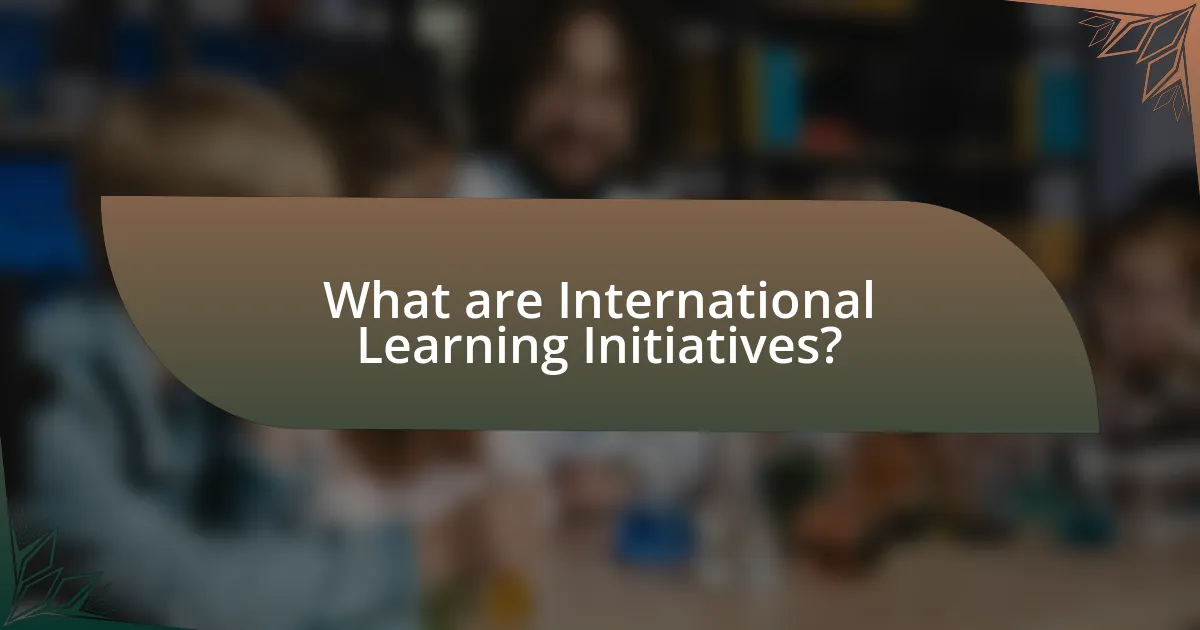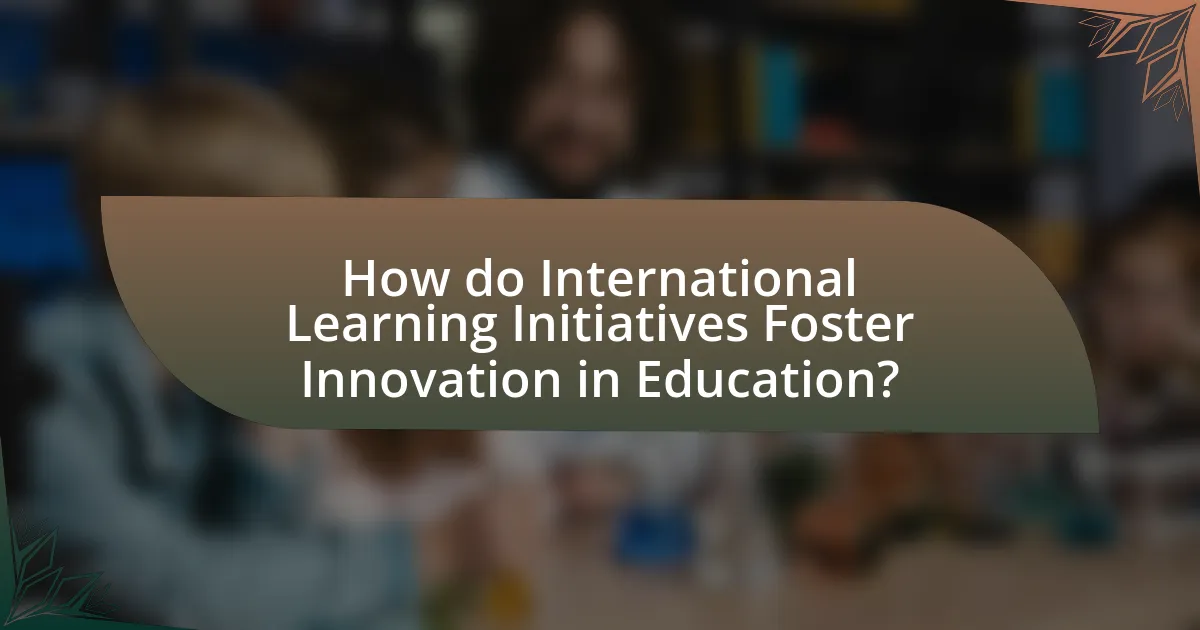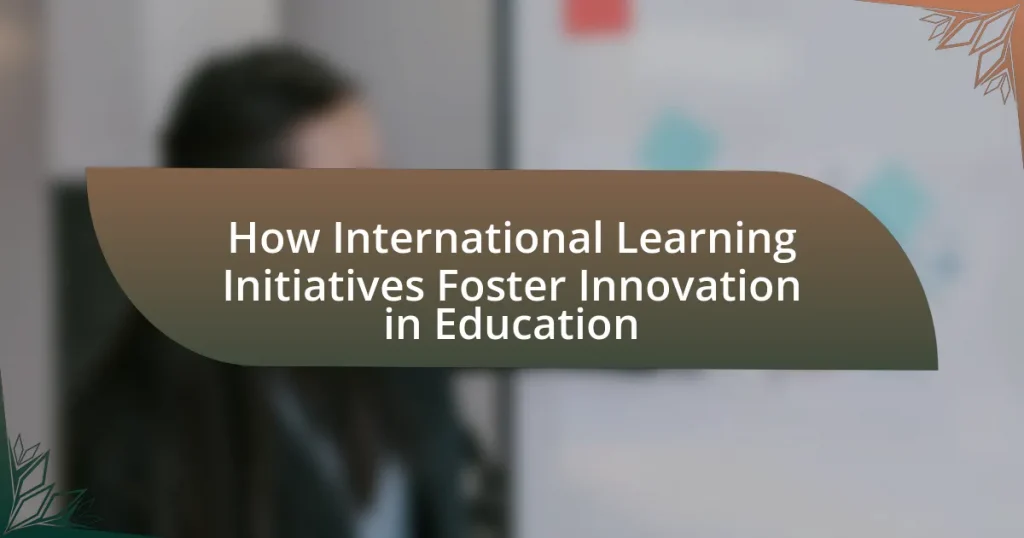International Learning Initiatives are collaborative educational programs aimed at enhancing teaching practices and learning outcomes through cross-border partnerships. These initiatives, such as the International Baccalaureate and Erasmus+, emphasize global collaboration, cultural exchange, and innovative methodologies, contrasting with traditional localized educational approaches. The article explores how these initiatives foster innovation in education by promoting diverse perspectives, improving student engagement, and preparing learners for a global workforce. It also addresses the challenges faced, such as cultural differences and varying educational standards, while highlighting best practices for effective collaboration and the role of technology in facilitating these initiatives.

What are International Learning Initiatives?
International Learning Initiatives are collaborative programs designed to enhance educational practices across borders by sharing knowledge, resources, and methodologies. These initiatives often involve partnerships between educational institutions, governments, and organizations to promote best practices and innovative teaching strategies. For example, programs like the International Baccalaureate and Erasmus+ facilitate student and teacher exchanges, fostering a global perspective in education. Such initiatives have been shown to improve educational outcomes by integrating diverse cultural insights and pedagogical approaches, thereby driving innovation in teaching and learning processes.
How do International Learning Initiatives differ from traditional educational methods?
International Learning Initiatives differ from traditional educational methods primarily in their emphasis on global collaboration and cross-cultural experiences. Traditional educational methods often focus on localized curricula and standardized testing, while International Learning Initiatives promote diverse perspectives and real-world problem-solving through partnerships across countries. For example, programs like the International Baccalaureate (IB) encourage students to engage with global issues, fostering critical thinking and adaptability, which are essential skills in today’s interconnected world. This approach not only enhances cultural awareness but also prepares students for a global workforce, contrasting sharply with the more insular focus of conventional education systems.
What are the key characteristics of International Learning Initiatives?
International Learning Initiatives are characterized by collaboration across borders, a focus on cultural exchange, and the integration of diverse educational practices. These initiatives promote global citizenship by encouraging students to engage with different cultures and perspectives, enhancing their critical thinking and adaptability. For example, programs like the Erasmus+ initiative in Europe facilitate student mobility and partnerships between institutions, demonstrating the effectiveness of cross-cultural collaboration in education. Additionally, these initiatives often leverage technology to connect learners worldwide, making education more accessible and inclusive.
How do these initiatives promote cross-cultural understanding?
International learning initiatives promote cross-cultural understanding by facilitating direct interactions among diverse cultural groups, which enhances mutual respect and appreciation. These initiatives often include exchange programs, collaborative projects, and joint research efforts that immerse participants in different cultural contexts. For instance, studies show that students who engage in international exchanges report increased cultural awareness and empathy, as they learn to navigate and appreciate different perspectives. This exposure not only broadens their worldview but also fosters communication skills essential for global citizenship.
Why are International Learning Initiatives important for education?
International Learning Initiatives are important for education because they promote cross-cultural collaboration and knowledge exchange, enhancing the learning experience. These initiatives enable students and educators to access diverse perspectives and innovative teaching methods, which can lead to improved educational outcomes. For instance, programs like the Erasmus+ initiative in Europe have facilitated over 10 million student exchanges since its inception, demonstrating the tangible benefits of international collaboration in education. Such initiatives not only enrich the curriculum but also prepare students for a globalized workforce by fostering skills such as adaptability and intercultural communication.
What impact do these initiatives have on student engagement?
International learning initiatives significantly enhance student engagement by promoting active participation and collaboration among learners. These initiatives often incorporate diverse teaching methods, such as project-based learning and cross-cultural exchanges, which have been shown to increase motivation and interest in academic subjects. For instance, a study published in the Journal of Educational Psychology found that students involved in international programs reported a 30% increase in engagement levels compared to their peers in traditional settings. This increase is attributed to the exposure to different perspectives and the opportunity to work on real-world problems, fostering a sense of ownership and relevance in their education.
How do they contribute to global citizenship education?
International learning initiatives contribute to global citizenship education by promoting cross-cultural understanding and collaboration among students from diverse backgrounds. These initiatives facilitate experiential learning opportunities, such as exchange programs and collaborative projects, which enhance students’ awareness of global issues and cultural perspectives. For instance, programs like the International Baccalaureate emphasize intercultural understanding and respect, equipping students with the skills necessary to engage in a globalized world. Research indicates that students involved in such initiatives demonstrate increased empathy and a stronger sense of social responsibility, which are essential components of global citizenship education.

How do International Learning Initiatives Foster Innovation in Education?
International learning initiatives foster innovation in education by promoting collaboration and knowledge exchange among diverse educational systems. These initiatives, such as the Global Partnership for Education, enable countries to share best practices, resources, and innovative teaching methods, which can lead to improved educational outcomes. For instance, the OECD’s PISA assessments encourage countries to analyze their educational strategies and adopt successful practices from others, resulting in enhanced curriculum development and teaching approaches. Additionally, international partnerships often provide funding and support for innovative projects, such as technology integration in classrooms, which can transform traditional learning environments into more engaging and effective spaces.
What innovative practices emerge from International Learning Initiatives?
Innovative practices that emerge from International Learning Initiatives include collaborative online learning platforms, cross-cultural exchange programs, and project-based learning that integrates global perspectives. Collaborative online learning platforms, such as MOOCs (Massive Open Online Courses), enable students from diverse backgrounds to engage in shared learning experiences, fostering a global classroom environment. Cross-cultural exchange programs allow students to immerse themselves in different educational systems, enhancing their adaptability and cultural awareness. Project-based learning that incorporates global issues encourages students to work on real-world problems, promoting critical thinking and innovation. These practices are supported by research indicating that exposure to diverse educational methodologies enhances creativity and problem-solving skills among students.
How do collaborative projects enhance creativity in learning?
Collaborative projects enhance creativity in learning by fostering diverse perspectives and encouraging idea exchange among participants. When individuals from different backgrounds and skill sets work together, they combine their unique insights, leading to innovative solutions and creative problem-solving. Research indicates that collaboration stimulates cognitive processes, as seen in a study by Johnson and Johnson (2009), which found that cooperative learning environments significantly improve critical thinking and creativity compared to individual work. This synergy not only enriches the learning experience but also cultivates an environment where creativity can thrive through shared knowledge and collective brainstorming.
What role does technology play in fostering innovation through these initiatives?
Technology serves as a catalyst for innovation in international learning initiatives by enabling access to diverse educational resources and facilitating collaboration across borders. For instance, online platforms and digital tools allow educators and students from different countries to share knowledge, experiences, and best practices, thereby enhancing the learning process. According to a report by the World Economic Forum, technology integration in education can improve student engagement and learning outcomes by up to 30%. This demonstrates that technology not only supports the dissemination of innovative teaching methods but also fosters a global exchange of ideas, ultimately driving educational advancement.
How do educators benefit from participating in International Learning Initiatives?
Educators benefit from participating in International Learning Initiatives by gaining exposure to diverse teaching methodologies and educational practices. This exposure enhances their pedagogical skills and fosters innovative approaches to curriculum development. For instance, educators who engage in these initiatives often collaborate with international peers, leading to the exchange of best practices and ideas that can be adapted to their local contexts. Research indicates that such collaborations can improve student engagement and learning outcomes, as educators implement new strategies learned from their international counterparts.
What professional development opportunities arise from these initiatives?
International learning initiatives provide professional development opportunities such as cross-cultural collaboration, enhanced teaching methodologies, and access to global educational resources. These initiatives enable educators to engage with diverse perspectives, fostering innovative practices that can be integrated into their own teaching environments. For instance, programs like the Fulbright Teacher Exchange allow educators to share best practices and adapt new strategies, which has been shown to improve student engagement and learning outcomes. Additionally, participation in international conferences and workshops offers networking opportunities that can lead to collaborative projects and further professional growth.
How do educators share best practices across borders?
Educators share best practices across borders primarily through international collaborations, online platforms, and professional networks. These methods facilitate the exchange of innovative teaching strategies and resources among educators from different countries. For instance, organizations like the International Society for Technology in Education (ISTE) provide forums and conferences where educators can connect and share experiences. Additionally, platforms such as Edutopia and various social media groups enable educators to discuss and disseminate effective practices globally. Research indicates that such collaborative efforts enhance educational outcomes by integrating diverse perspectives and methodologies, thereby fostering innovation in teaching and learning.

What challenges do International Learning Initiatives face?
International Learning Initiatives face several challenges, including cultural differences, funding limitations, and varying educational standards. Cultural differences can lead to misunderstandings and misalignment in educational goals, making collaboration difficult. Funding limitations often restrict the scope and sustainability of these initiatives, as many rely on grants or donations that may not be consistent. Additionally, varying educational standards across countries can create disparities in curriculum and assessment, complicating the implementation of a unified learning approach. These challenges hinder the effectiveness and scalability of International Learning Initiatives in fostering innovation in education.
How can cultural differences impact the effectiveness of these initiatives?
Cultural differences can significantly impact the effectiveness of international learning initiatives by influencing communication styles, learning preferences, and collaboration methods. For instance, cultures that prioritize collectivism may favor group-oriented projects, while individualistic cultures might emphasize personal achievement. Research by Hofstede (1980) highlights that cultural dimensions, such as power distance and uncertainty avoidance, shape how individuals engage in educational settings. In a study published in the Journal of International Education in Business, authors M. A. A. Alon and J. M. McIntyre (2008) found that mismatched cultural expectations can lead to misunderstandings and reduced participation, ultimately hindering the success of educational programs. Thus, recognizing and adapting to these cultural differences is essential for enhancing the effectiveness of international learning initiatives.
What strategies can be employed to overcome language barriers?
To overcome language barriers, employing strategies such as using translation technology, fostering bilingual education, and promoting cultural exchange programs is essential. Translation technology, including apps and software, facilitates real-time communication and understanding between speakers of different languages. Bilingual education programs enhance language skills and cultural awareness, allowing students to learn in both their native language and a second language, which has been shown to improve cognitive abilities and academic performance. Cultural exchange programs provide immersive experiences that encourage language practice and cultural appreciation, leading to better communication skills. These strategies have been validated by research indicating that effective language support enhances learning outcomes in diverse educational settings.
How do varying educational standards affect collaboration?
Varying educational standards significantly affect collaboration by creating disparities in knowledge and skills among participants. When educational standards differ, individuals from various backgrounds may struggle to communicate effectively, leading to misunderstandings and inefficiencies in collaborative efforts. For instance, a study by the Organisation for Economic Co-operation and Development (OECD) highlights that countries with aligned educational standards tend to have more successful collaborative projects, as participants share a common framework of knowledge and expectations. This alignment fosters smoother interactions and enhances the overall effectiveness of collaborative initiatives in educational contexts.
What are the future trends for International Learning Initiatives?
Future trends for International Learning Initiatives include increased integration of technology, a focus on personalized learning experiences, and the promotion of global citizenship. The integration of technology is evidenced by the rise of online platforms and digital resources that facilitate cross-border collaboration and access to diverse educational materials. Personalized learning experiences are becoming more prevalent as educators recognize the need to tailor instruction to individual student needs, supported by data analytics and adaptive learning technologies. Additionally, the emphasis on global citizenship is reflected in curricula that encourage students to engage with global issues, fostering a sense of responsibility and interconnectedness. These trends are shaping the future of education by enhancing accessibility, engagement, and relevance in a rapidly changing world.
How might globalization influence the evolution of these initiatives?
Globalization significantly influences the evolution of international learning initiatives by facilitating cross-border collaboration and knowledge exchange. This interconnectedness allows educational institutions to adopt diverse pedagogical approaches and curricula from various cultures, enhancing innovation in teaching methods. For instance, the rise of online learning platforms, driven by globalization, enables educators to access global resources and best practices, leading to improved educational outcomes. Furthermore, international partnerships foster research collaborations that can address global challenges, such as climate change and public health, thereby enriching the educational landscape and promoting a more holistic approach to learning.
What role will digital platforms play in the future of international education?
Digital platforms will serve as essential tools for enhancing accessibility and collaboration in international education. These platforms facilitate remote learning, enabling students from diverse geographical locations to access quality educational resources and connect with peers and educators worldwide. For instance, a report by the World Economic Forum highlights that online learning platforms can increase enrollment rates by up to 30% in higher education institutions, demonstrating their potential to broaden educational opportunities. Additionally, digital platforms support innovative teaching methods, such as blended learning and interactive content, which can improve student engagement and learning outcomes.
What best practices can enhance the effectiveness of International Learning Initiatives?
Best practices that can enhance the effectiveness of International Learning Initiatives include fostering collaboration among diverse stakeholders, integrating technology for accessibility, and emphasizing cultural sensitivity. Collaboration among educational institutions, governments, and NGOs can create a supportive network that shares resources and expertise, as evidenced by the success of programs like the Erasmus+ initiative, which has facilitated over 9 million student exchanges since its inception in 1987. Integrating technology, such as online learning platforms, ensures that learners from various backgrounds can access quality education regardless of geographical barriers, demonstrated by the rise of MOOCs (Massive Open Online Courses) that have enrolled millions globally. Lastly, emphasizing cultural sensitivity in curriculum design and delivery promotes inclusivity and respect for diverse perspectives, which is crucial for the success of international initiatives, as highlighted by research from the Journal of Studies in International Education, which found that culturally responsive teaching significantly improves student engagement and learning outcomes.
How can institutions effectively measure the impact of these initiatives?
Institutions can effectively measure the impact of international learning initiatives by utilizing a combination of quantitative and qualitative assessment methods. Quantitative metrics may include standardized test scores, graduation rates, and enrollment statistics, which provide concrete data on academic performance and retention. Qualitative assessments, such as surveys and interviews with students and educators, can offer insights into personal experiences and perceived benefits of the initiatives.
For instance, a study by the Organisation for Economic Co-operation and Development (OECD) found that countries implementing international educational programs saw a 15% increase in student engagement and a 10% improvement in critical thinking skills, demonstrating measurable outcomes linked to these initiatives. By triangulating data from both quantitative and qualitative sources, institutions can gain a comprehensive understanding of the initiatives’ effectiveness and areas for improvement.
What are the key elements for successful collaboration in international education?
The key elements for successful collaboration in international education include clear communication, mutual respect, shared goals, and cultural awareness. Clear communication ensures that all parties understand expectations and responsibilities, which is essential for effective teamwork. Mutual respect fosters a positive environment where diverse perspectives are valued, enhancing collaboration. Shared goals align the efforts of different stakeholders, creating a unified direction for the initiative. Cultural awareness allows participants to navigate differences and leverage diverse backgrounds, which can lead to innovative solutions. These elements are supported by research indicating that effective collaboration in educational settings significantly improves outcomes and fosters innovation.
